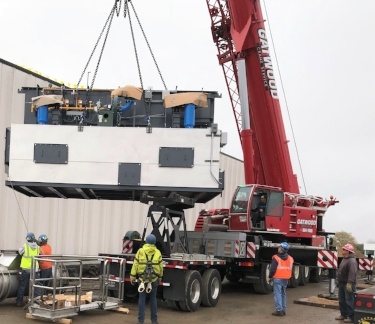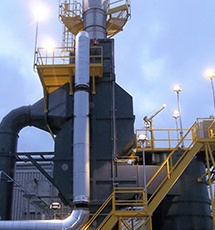Catalytic Products International (CPI) recently completed the installation of a new TRITON Series Regenerative Thermal Oxidizer (RTO) at the Midwest USA location of a global manufacturer and supplier of flavorings, extracts and essences for the abatement of Volatile Organic Compounds (VOCs) and odors.
The manufacturing of powdered and liquid flavorings & fragrances involves production phases where VOCs and odors can escape into the ambient air. The generation of odors can be considered a nuisance by local communities. To ensure the destruction of VOCs and prohibit the generation of nuisance causing odors, this customer chose to implement a Regenerative Thermal Oxidizer (RTO).
 The new 10,000 SCFM TRITON-10.95 Regenerative Thermal Oxidizer (RTO) will control VOC emissions from four (4) existing ingredient spray dryers and one (1) ingredient spray dryer slated for future installation. The RTO system meets the air permit requirements to destroy VOC emissions with 98% destruction efficiency or to a lower limit of 30 ppm volume as C1 at a thermal efficiency of 95%.
The new 10,000 SCFM TRITON-10.95 Regenerative Thermal Oxidizer (RTO) will control VOC emissions from four (4) existing ingredient spray dryers and one (1) ingredient spray dryer slated for future installation. The RTO system meets the air permit requirements to destroy VOC emissions with 98% destruction efficiency or to a lower limit of 30 ppm volume as C1 at a thermal efficiency of 95%.
CPI designed and supplied a stainless-steel VOC collection system connecting all five (5) spray dryer exhaust ducts to the oxidizer. Each spray dryer exhaust was picked up above roof level, transitioning to an appropriately sized branch duct, run through the damper assemblies to a common main header leading to the oxidizer.
Thermal treatment of VOCs and other air pollutants works by a simple reaction of the harmful hydrocarbon-based air pollutants with oxygen and heat. In this environment, the VOCs are chemically oxidized to form harmless inert by-products like CO2, water vapor (H2O), and usable heat. These harmless by-products are released to the atmosphere or used within primary or secondary energy recovery techniques to further lower the operational costs.
TRITON Series Regenerative Thermal Oxidizers (RTOs) are two-tower systems engineered to provide exceptional performance and reliability. During operation of the RTO the VOCs are ducted into one of the system’s regenerators, an internally insulated vessel containing specialized ceramic media which allows thermal rate efficiencies up to 97%. The contaminated gases are passed through the first regenerator where energy is transferred from the ceramic media to the gases in order to elevate the temperature of the gases. After reaching this elevated temperature which approaches the ignition level for most solvents, the gases are directed to the internally lined combustion chamber. In the combustion chamber minimal heat is added to ensure a proper oxidation temperature and designed dwell time and turbulence are maintained providing destruction of the VOCS at greater than 98% efficiency. The resultant clean, oxidized gases are redirected into a second regenerator bed to continue the energy transfer and oxidation cycle before being released to the atmosphere.

Catalytic Products International (CPI) provided a complete turnkey installation, including design and supply of the Regenerative Thermal Oxidizer (RTO), electrical work, natural gas supply and compressed air piping, stainless steel ductwork and system startup. CPI worked closely with the customer to minimize the downtime associated with the installation of the Regenerative Thermal Oxidizer (RTO). CPI was able to complete a good portion of the installation activities before the new unit arrived on site and delivered the TRITON-10.95 RTO fully shop assembled and skid mounted with the media installed. CPI also provided on-site supervision to ensure coordination with the third-party sub-contractors. This approach guaranteed that entire system was installed correctly, and the facility was back up and producing product with minimal downtime.
Since 1969 CPI has been providing industry leading flavoring and fragrance manufacturers with solutions to their air pollution control needs.
Today, CPI partners with its customers as a trusted resource in resolving the most complex air pollution and energy conservation problems. We provide our customers with innovative and cost-conscious solutions to their most complex VOC, NOx, and Odor pollution challenges. Our equipment is also at work meeting energy conservation strategies and minimizing greenhouse gas (GHG) emissions.








